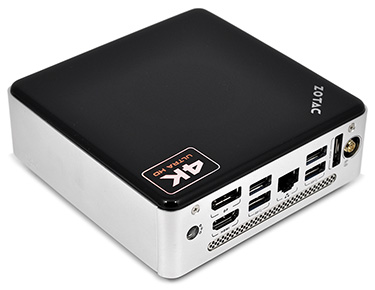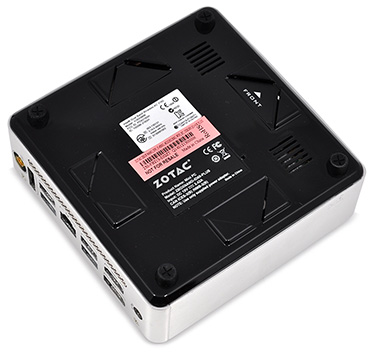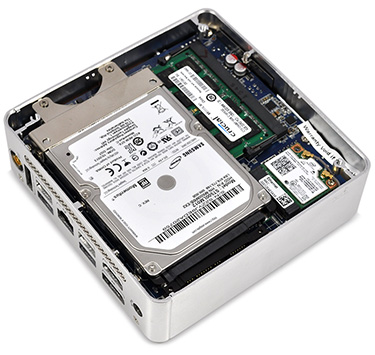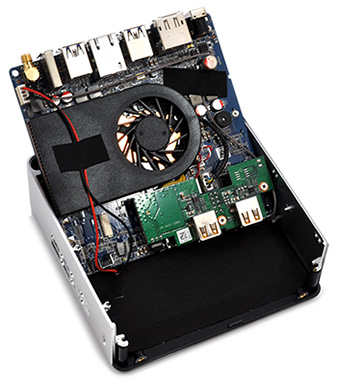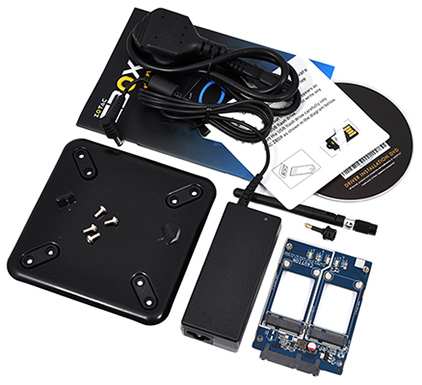Pint-Sized Intel Haswell
The number of ultra-small PCs arriving on the market is a sign of the times. The industry is slowly-but-surely making the transition to petite, efficient devices that are more capable than ever before, and if chip giant Intel has a say in things, the PC of tomorrow will be no bigger than a box of chocolates.
It's telling that a few of the HEXUS staff are now more intrigued by these little systems than they are by the big behemoths that typically cross our path. So much so, in fact, that a couple of our team have already downsized from full-tower machines to NUCs or something of a similar size.
But what this area of the market really needs is choice, and lots of it. Anyone building a traditional tower has a smorgasbord of components to choose from - that's half the fun - however if you want something that's significantly smaller, your options are limited. This should become less of a problem in 2014 as more manufacturers make the move to small-form-factor (SFF), but right now the mini PC continues to be championed by a select few.
One brand well known for its SFF efforts is Zotac, who in recent years has built up an award-winning catalogue of mini PCs under the Zbox brand. The most recent addition is the Zbox Nano ID69 Plus, priced at £520, which takes a fourth-generation Intel Core processor and crams it inside one of the company's smallest enclosures.
It's good to see the latest Intel chips making their way into the Zbox range, but £520 feels like a lot of money for a teeny-tiny bit of kit, and it's a shame Zotac hasn't spruced up the chassis to give it a premium feel that would be in keeping with the price tag. The same enclosure has been a mainstay in Zotac's range for quite some time, and we were quietly hoping for an all-metal upgrade.
That wasn't to be, yet the existing chassis isn't necessarily a bad thing. Measuring 127mm x 127mm x 45mm in size, it's suitably small and well presented. An aluminium surround provides a good amount of rigidity, and the top and bottom covers are a shiny-black plastic that, while not as elegant or robust as metal, work well enough.
There are no obvious changes in terms of layout or connectivity. The air vent on one side continues to service the single internal fan, while the front panel sports a power button, a couple of activity LEDs, an IR receiver, and a multi-card reader that sits along two USB 2.0 ports, and audio and microphone jacks.
Around back, the Zbox Nano offers a connector for the bundled 65W external power supply, full-sized DisplayPort and HDMI video outputs, four USB 3.0 ports, Gigabit Ethernet, eSATA and a connector for the bundled WiFi antenna. Overall connectivity is good and well-suited to most usage scenarios, but it's a shame Zotac doesn't bundle a remote control or IR receiver extension - both of which are included with the standard Zbox. Worth noting, also, that without dedicated audio outputs around back, connecting external speakers can be cumbersome.
There's little to write home about as far as external appearance is concerned, so it's up to the internal hardware to make the difference. For this latest-generation model, Zotac has turned to Intel's Core i7-4500U, a dual-core, hyper-threaded processor with 4MB of onboard cache and integrated HD 4400 graphics.
A fourth-generation Intel Core processor is always likely to return excellent CPU performance, yet what makes the i7-4500U a particularly attractive proposition is the low-power 15W TDP. This energy-efficient chip is designed to run at speeds of up to 3GHz, but it's ultimately the frugal power draw that makes it a good fit for a mini PC.
The processor could rightly be seen as a technological marvel, however it does come at a substantial cost. Intel's recommended tray price for the Core i7-4500U is a hefty $393 (£239+VAT), meaning more than half the cost of the latest Zbox Nano can be attributed to the processor alone.
Looking beyond the headline component, would-be buyers will find four rubber feet beneath the Zbox Nano chassis that can be unscrewed to gain access to two user-upgradeable components; a 500GB Samsung 5,400RPM hard disk; and 4GB of Crucial DDR3 1,600 memory.
Plenty of storage for those who need it, though we'd happily have traded a 500GB hard disk for a 120GB solid-state drive - in our opinion, the performance advantages of SSD technology far outweigh the capacity benefits of a traditional mechanical drive. It's also interesting that Zotac's configuration has only one DIMM slot, compared to two on Intel's NUC. This seems an unnecessary restriction and makes future upgrades more difficult than they might have been.
Removing the motherboard isn't recommended - it will void your warranty - but in doing so we can get a look at the fan that's tasked with cooling the 22nm Intel chip. The small exhaust is designed to blow hot air out the side of the chassis, however while it's more than capable of keeping the processor running cool under load, it does have a tendency to ramp-up in speed and generate unwanted noise.
We've kept the Zbox Nano on top of our desk alongside the monitor for the best part of the week, and in a quiet office you do notice that it's there. The fan speed appears to change and react to even light CPU load - carrying out Windows Updates, for example, is enough to raise the noise level a notch. Though, it's worth keeping system noise in perspective - we're self-confessed advocates of silent PCs, and though we'd like the Zbox Nano to be quieter, it's by no means loud and probably won't bother most users.
Outside of the box itself, Zotac's bundle has a fair amount to offer. It includes a VESA-compliant mount that can be used to attach the Zbox Nano to the rear of a monitor/TV (the system is otherwise designed to sit horizontally), as well as an mSATA RAID adapter that allows the 2.5in hard drive to be swapped out for dual mSATA SSDs. Elsewhere, we have a WiFi antenna, a 3.5mm to optical audio adapter, a software CD and, better still, a small USB thumb drive preloaded with all the relevant drivers.
As has historically been the case, Zotac will offer the latest Zbox Nano in two unique models. The ID69 Plus, detailed above and priced at £520, includes the hard disk and 4GB of memory. Consumers wanting to configure their own box can look forward to the standard ID69, which will set you back £440 and ship with no storage or RAM. Remember, too, that neither box is provided with an operating system, so that's another a potential cost to take into account.
Let's now see what that low-power Core i7 chip can really do.







